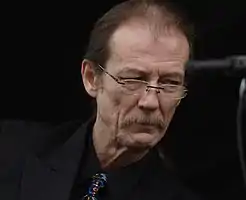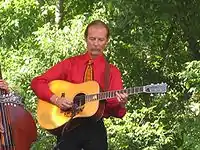Tony Rice
David Anthony Rice (June 8, 1951 – December 25, 2020) was an American guitarist and bluegrass musician. He was an influential acoustic guitar player in bluegrass, progressive bluegrass, newgrass and acoustic jazz.[2][3] He was inducted into the International Bluegrass Music Hall of Fame in 2013.[4]
Tony Rice | |
|---|---|
 | |
| Background information | |
| Birth name | David Anthony Rice |
| Born | June 8, 1951 Danville, Virginia, U.S. |
| Died | December 25, 2020 (aged 69)[1] Reidsville, North Carolina, U.S. |
| Genres | Americana, bluegrass, folk, jazz |
| Occupation(s) | Musician, songwriter |
| Instruments | Guitar |
| Years active | 1970–2013 |
| Labels | Rounder, Sugarhill Acoustic Disc, Mountain Home |
| Associated acts | The Bluegrass Alliance, J.D. Crowe & The New South, David Grisman Quintet, Bluegrass Album Band, The Tony Rice Unit |
Rice's music spans the range of acoustic from traditional bluegrass to jazz-influenced New Acoustic music to songwriter-oriented folk. Over the course of his career, he played alongside J. D. Crowe and the New South, David Grisman (during the formation of "Dawg Music") and Jerry Garcia, led his own Tony Rice Unit, collaborated with Norman Blake, recorded with his brothers Wyatt, Ron, and Larry, and co-founded the Bluegrass Album Band. He recorded with drums, piano, soprano sax, as well as with traditional bluegrass instrumentation.[5][6]
Early years
Rice was born in Danville, Virginia but grew up in Los Angeles, California, where his father, Herb Rice, introduced him to bluegrass. Tony and his brothers learned the fundamentals of bluegrass and country music from L.A. musicians like the Kentucky Colonels, led by Roland and Clarence White. Clarence White in particular became a huge influence on Rice. Crossing paths with fellow enthusiasts like Ry Cooder, Herb Pedersen and Chris Hillman reinforced the strength of the music he had learned from his father.[7]
Groups

In 1970, Rice had moved to Louisville, Kentucky where he played with the Bluegrass Alliance, and shortly thereafter, J.D. Crowe's New South. The New South was known as one of the best and most progressive bluegrass groups—eventually adding drums and electric instruments (to Rice's displeasure). When Ricky Skaggs joined them in 1974, however, the band recorded J. D. Crowe & the New South, an acoustic album that became Rounder Records' top-seller up to that time. At this point, the group consisted of Rice on guitar and lead vocals, Crowe on banjo and vocals, Jerry Douglas on Dobro, Skaggs on fiddle, mandolin, and tenor vocals, and Bobby Slone on bass and fiddle.
Around this time, Rice met mandolinist David Grisman, who played with Red Allen during the 1960s and was now working on original material that blended jazz, bluegrass, and classical styles. Rice left the New South and moved to California to join Grisman's all-instrumental group. As part of the David Grisman Quintet, in order to broaden his expertise and make himself more marketable, Rice began studying chord theory, learned to read charts, and began to expand his playing beyond bluegrass. Renowned guitarist John Carlini came in to teach Rice music theory, and Carlini helped him learn the intricacies of jazz playing and musical improvisation, in general. The David Grisman Quintet's 1977 debut recording is considered a landmark of acoustic string band music.
In 1980, Rice, Crowe, Bobby Hicks, Doyle Lawson and Todd Phillips formed the Bluegrass Album Band and recorded from 1980 to 1996.
With the Tony Rice Unit, he pursued experimental "spacegrass" music on Mar West, Still Inside, and Backwaters. Members of the Unit included Jimmy Gaudreau (mandolin), Wyatt Rice (guitar), Ronnie Simpkins (bass), and Rickie Simpkins (fiddle). In the late 1980s Alison Krauss played regularly with the group in concert for about a year but never appeared on the albums. Alison Brown also guested with the group during that period.[8]
Collaborations
In 1980, he recorded an album of bluegrass duets with Ricky Skaggs, called Skaggs & Rice. Two albums with traditional instrumentalist and songwriter Norman Blake garnered acclaim, as well as two Rice Brothers albums (1992 and 1994) that featured him teamed with his late elder brother, Larry, and younger brothers, Wyatt and Ronnie.
Beginning in 1984, Rice collaborated on four albums by Béla Fleck – Double Time (Béla Fleck album) (1984), Drive (Béla Fleck album) (1988), Tales from the Acoustic Planet (1995), and The Bluegrass Sessions: Tales from the Acoustic Planet, Vol. 2 (1999).
He joined David Grisman and Jerry Garcia in 1993 to record The Pizza Tapes. In 1994 Rice and Grisman recorded Tone Poems, an original collection of material, where they used historical vintage mandolins and guitars, different for each track.
In 1994, Rice joined Mark Johnson to record "Clawgrass Mark Johnson with the Rice Brothers and Friends" which featured Tony as well as his late brother Larry Rice and his other brothers Wyatt and Ronnie.
In 1995, Rice recorded a duo album with John Carlini, who also played with the David Grisman Quintet.
In 1997, Rice, his brother Larry, Chris Hillman (formerly of the Flying Burrito Brothers and the Byrds) and banjoist Herb Pedersen founded the so-called "anti-supergroup" Rice, Rice, Hillman & Pedersen[9] and produced three volumes of music between 1997 and 2001.
In the 2000s and 2010s, he performed as a quartet with guitarist/singer-songwriter Peter Rowan, bassist Bryn Bright (later known as Bryn Davies), and mandolinist Billy Bright (replaced by Sharon Gilchrist).
Solo career
In 1979, Rice left Grisman's group to record Acoustics, a jazz-inspired album, and then Manzanita,[10] a bluegrass and folk album. A similar combination was evident on Cold on the Shoulder, Native American, and Me & My Guitar, albums which combined bluegrass, jazzy guitar work, and the songwriting of Ian Tyson, Joni Mitchell, Phil Ochs, Tom Paxton, Bob Dylan, and Gordon Lightfoot.
Rice's singing voice was a distinctive baritone. In 1994 he was diagnosed with a disorder known as muscle tension dysphonia and as a result was forced to stop singing in live performance.[11] A 2014 diagnosis of lateral epicondylitis ("tennis elbow") made guitar playing painful and Rice's last performance playing guitar live was his induction into the International Bluegrass Music Hall of Fame in 2013. In 2015, Rice was quoted as saying "I am not going to go back out into the public eye until I can be the musician that I was, where I left off or better. I have been blessed with a very devout audience all these years, and I am certainly not going to let anybody down. I am not going to risk going out there and performing in front of people again until I can entertain them in a way that takes away from them the rigors and the dust, the bumps in the road of everyday life."[12]
The authorized biography of Tony Rice, titled Still Inside: The Tony Rice Story, written by Tim Stafford and Hawaii-based journalist Caroline Wright, was published by Word of Mouth Press in Kingsport, Tennessee, United States in 2010. The book's official release took place at Merlefest in North Carolina.[13][14]
Death
Tony Rice died at his home in Reidsville, North Carolina on December 25, 2020. He died while making his coffee, according to a statement from longtime friend and collaborator Ricky Skaggs.[15]
Rice’s 2013 induction into the International Bluegrass Hall of Fame reportedly was the last time he played guitar in public due to the lateral epicondylitis that affected his ability to play in his last years.
Discography
Awards
Grammy
- Best Country Instrumental Performance – The New South, Fireball – 1983[16]
IBMA
- Hall of Fame Inductee, 2013[17][18]
- Instrumental Performer of the Year – Guitar – 1990, 1991, 1994, 1996, 1997, 2007[18]
- Instrumental Group of the Year – The Tony Rice Unit – 1991, 1995[18]
- Instrumental Group of the Year – Bluegrass Album Band – 1990[18]
- Instrumental Album of the Year – Bluegrass Instrumentals, Volume 6 (Rounder) ; Bluegrass Album Band – 1997[18]
References
- @IntlBluegrass (December 26, 2020). "It is with a heavy heart we say goodbye to one of the most iconic voices & musicians in bluegrass" (Tweet) – via Twitter.
- Kimsey, Bryan. "Tony Rice – Featured Artist". Archived from the original on October 2, 2013.
- "Bluegrass Australia – Home Page". Bluegrass.org.au. December 24, 2011. Retrieved April 15, 2015.
- "The Gibson Brothers – for the Second Year in a Row – Named Entertainer of the Year at 2013 IBMA Music Awards | International Bluegrass Music Association". Ibma.org. Archived from the original on September 29, 2013. Retrieved April 15, 2015.
- Craig Harris (June 8, 1951). "Tony Rice | Biography". AllMusic. Retrieved April 15, 2015.
- "A day in the life of the world's best guitarist". Bluegrass Australia. Archived from the original on April 10, 2013.
- "Tony Rice". Tonyrice.com. Archived from the original on February 9, 2014. Retrieved April 15, 2015.
- Tony Rice, remarks from the stage, unreleased recording of Tony Rice Unit with Alison Krauss, live in Santa Cruz, California, 1989
- Zac Johnson (October 30, 2001). "Running Wild – Rice, Rice, Hillman & Pedersen | Songs, Reviews, Credits, Awards". AllMusic. Retrieved April 15, 2015.
- "TONY RICE: Manzanita: Music". Retrieved April 15, 2015.
- "AUDIO & VIDEO: A magical voice, silenced for 19 years, reappears at IBMA". Folk, Bluegrass & Traditional Music. September 28, 2013. Retrieved November 12, 2018.
- dawn.kane@greensboro.com, Dawn DeCwikiel-Kane/News & Record. "Rice's urge to perform remains strong, despite voice struggles". Greensboro News and Record. Retrieved November 12, 2018.
- "Still Inside: The Tony Rice Story". Tonyricestory.com. Retrieved April 15, 2015.
- "Tony Rice". Tonyrice.com. Archived from the original on July 9, 2011. Retrieved April 15, 2015.
- Willman, Chris (December 27, 2020). "Bluegrass Great Tony Rice Dies at 69". Variety. Retrieved December 27, 2020.
- Graves, Josh (2012). Bluegrass Bluesman: A Memoir. Urbana, Illinois: University of Illinois Press. p. 60. ISBN 9780252078644. Retrieved January 20, 2016.
- Beasley, Sandra (February 14, 2014). "Tony Rice, Guitar Hero". Magazine. New York Times. Retrieved January 20, 2016.
- "Recipient History". International Bluegrass Music Association. Archived from the original on January 3, 2018. Retrieved January 20, 2016.
External links
- Classicweb.com
- Tony Rice discography at Deaddisc.com
- Tony Rice discography at Discogs
